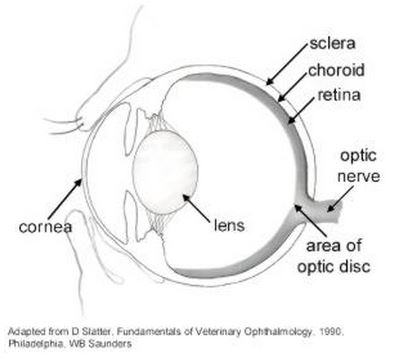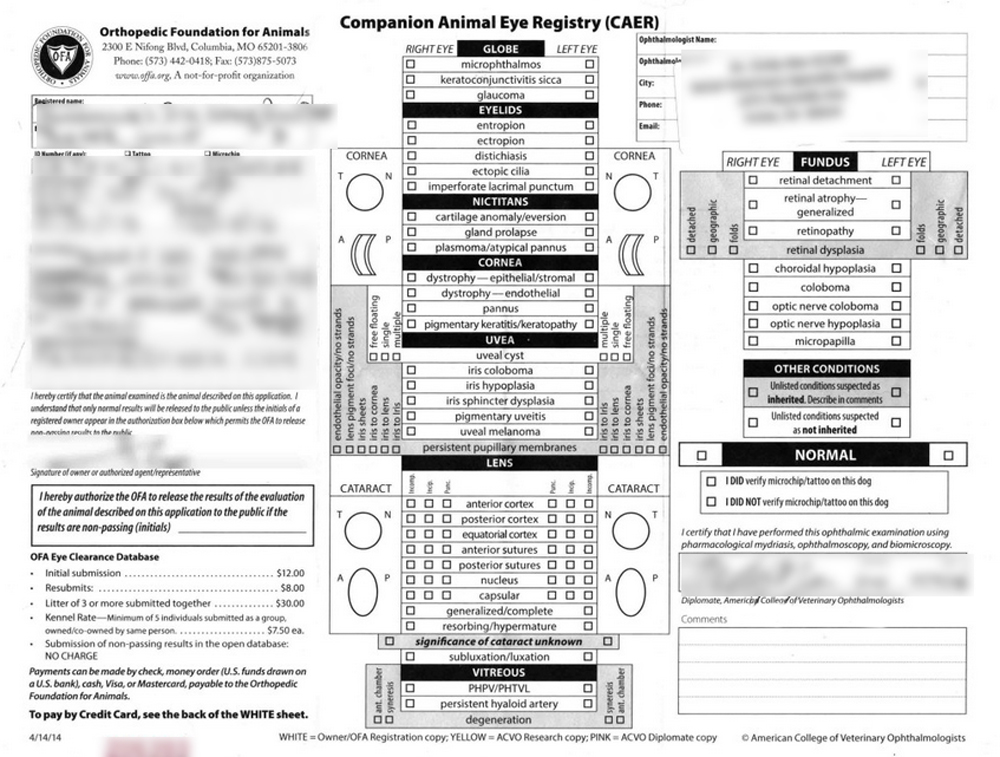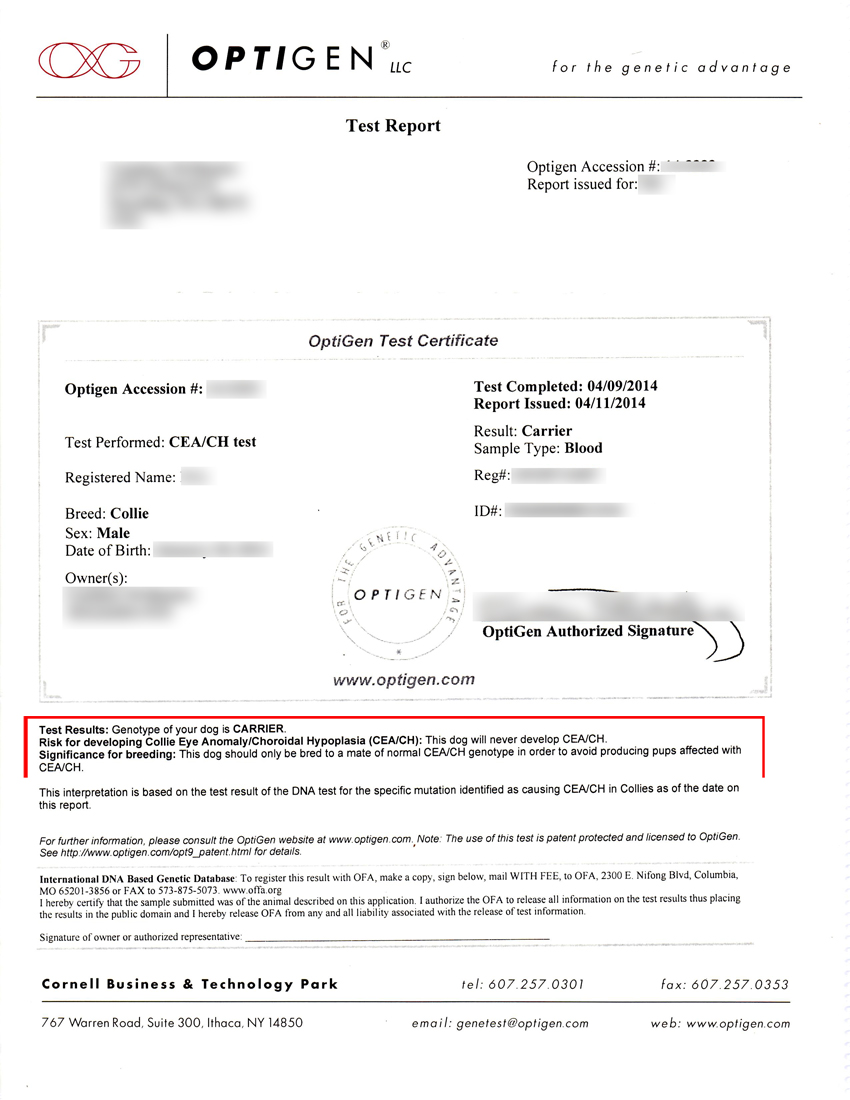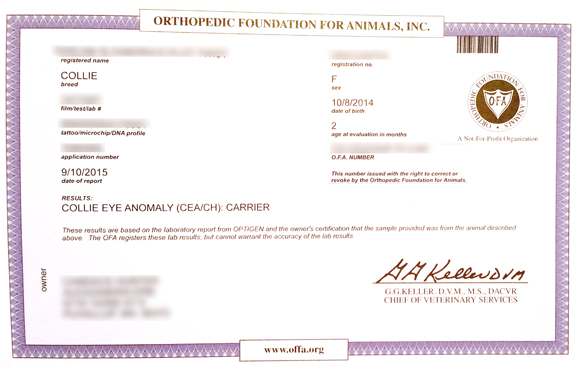
EYES
Canine Eye Anomaly
If you are looking at buying a Collie, understand CEA and how it can affect your choice.
CEA can also be referred to as CRC (Choroidal Retinal Change), Choroidal Hypoplasia (CH) but they all refer to the same issue with the eye. CEA has been around way before we had the option of eye checks or screening for genetic markers. CEA can affect other related ‘herding’ breeds including Shetland Sheepdogs, Australian Cattle Dogs and Border Collies among others. CEA affects from 70-85% of all Collies in the USA depending on the source of the statistics. Collies not affected by CEA are referred to as ‘Normal Eyed’ or NE. To complicate the issue there is a difference between genetically normal vs. exam normal which is discussed further down on this page.
CEA is a genetic disorder that effects the development of the choroid or sclera which lays under the retina of the eye. This under development of the choroid is referred to as hypoplasia hence the term choroidal hypoplasia or CH. The severity of the underdevelopment of the choroid can vary from mild to the more severe form termed a ‘coloboma’. If the underdevelopment affects the choroid, the defect is classified as a coloboma. If the underdevelopment affects the sclera, the defect is classified as a staphyloma. Whether the problem is referred to as CH or CEA, it is the same issue. There is no treatment or supplement that can be used to improve CEA – once the development of the choroid or sclera layer is affected, it cannot improve later in life.
The underdevelopment of the choroid or sclera, or ‘thinning’, produces a weakness in the layers of the eye which can result in a bulging or cupping as well as abnormal development of blood vessels in the area (also termed torturous vessels). The thinning of the choroid or sclera may also be referred to as a lesion. The majority of CEA affected dogs do not have the more severe form of the disease with a cupping or bulging visible. This thinning or lesion area can actually appear to ‘disappear’ if the color of the eye darkens as the dog matures. This darkening of the eye color can ‘mask’ the lesion if the eye is examined after the eye has sufficiently darkened (this time frame can vary from puppy hood to adult). This phenomenon is often termed as ‘masking’ or ‘go normal’ when exams are compared from when the dog is younger to older. The lesion still exists but it cannot be easily detected by examination as the dog matures. This is the reason it is important for exams to be done while the puppy is young and before the eye darkens with maturity. The eye generally completes development by 12 weeks of age.
Will My Collie Go Blind?
The short answer is quality of life vision impairment is rare. As mentioned previously the more severely affected eyes will have what are termed colobomas or staphylomas. Colobomas are generally on or near the optic nerve and they can lead to complications like partial or full retinal detachments resulting in partial or full blindness. Colobomas can also involve abnormal growth of blood vessels which could potentially lead to hemorrhaging. Staphyloma’s are located away from the optic nerve, happen less frequently than colobomas, and affect the sclera layer instead of the choroid. The eye screening done by the ophthalmologist can detect other anomalies beyond CEA. Examples include PPM’s (persistent pupillary membranes), abnormal eye lash growth, etc.

The vast majority of Collies with CEA do not exhibit any vision impairment behavior. A minority can experience loss of vision up to and including blindness when colobomas and staphylomas of sufficient size and in an optimum area develop into a partially or fully detached retina.
As noted previously, there is no treatment or cure for CEA. That being said, colobomas and staphylomas often remain unchanged throughout the dog’s life and may not lead to sight loss affecting the dogs’ quality of life. What causes a coloboma or a staphyloma to degenerate is the subject of much debate. It is generally accepted however that a puppy who was not found to have a coloboma or a staphyloma when young will not develop one when older. Any ‘late discovery’ of a coloboma or staphyloma likely has more to do with a less than optimal screening as a puppy than with any developmental component.
A collie with CEA and without a coloboma or staphyloma will not experience any further thinning of the choroid or sclera after the eye has finished developing at around 12 weeks of age. It is also possible that further exams into adulthood result in an improved rating due to the ‘masking’ of the lesions upon examination by the development of adult eye color. The lesions do not go away – they are just less visible upon exam.
While science does not yet allow us to see a true view of how our dogs see the world, observations do not show an appreciable difference between a dog with mild CEA lesions and a normal eyed or non-CEA affected dog. Collies who are genetically free of CEA should still be examined by an ophthalmologist to rule out any other eye disorders separate from genetic issues like CEA. Dogs with more severe lesions or colobomas or staphyloma’s may possibly experience some loss of sight in low light situations and potentially have issues with depth perception. That being said, owners who have experience with vision impaired dogs often report that the limitations do not have a significant impact on quality of life in the role of a companion. Being informed about what CEA means for your Collie will help you make the best decisions for you and your family.
Why Don’t Breeders Get Rid Of CEA?
While many websites and ophthalmologists state nothing but a ‘normal eyed’ Collie should be bred, this is not a realistic expectation and would effectively leave a gene pool so restricted that many other serious issues would develop. Imagine leaving only 15-30 % of the Collies in North America in the gene pool! It would guarantee the rise of many more serious problems thru the lack of genetic diversity and potential concentration of problems with a more serious impacts on the breed.
The challenge of a responsible breeder is to balance known genetic influences against the overall quality of life of the dog while meeting the requirements of the breed standard as defined by the Collie Club of America to keep the Collie looking like a Collie. The Collie was created to adhere to a specific look otherwise eventually all dogs revert to a wolfish wild type. The selective breeding over hundreds of years for the purpose of creating a willing, able bodied dog with eyes of sufficient size and placement to scan the land without being too large to potentially be damaged as they moved thru brush and brambles; a strong but long muzzle allowing for nipping without potential of being struck in the head by flying hooves; the tipped ear cupped for capturing the distant whistle of the herder while keeping out rain and debris; a dog of moderate length and height with a ground covering and effortless single tracking gate; a dog with a harsh outer texture to the coat with the necessary undercoat to withstand the elements – all features that breeders have fine tuned over the years to present the proud, elegant, nimble, inquisitive, sensitive, athletic Collie we cherish today. Finding a Collie that meets the standard of the breed out of the small percentage of normal eyed Collies is a huge challenge and I don’t believe it should be pursued at the expense of the rest of the dog. The Collie is a sum of its’ parts and each part must be considered to ensure the look, health, and temperament of the breed is not only maintained but improved. Breeding to the standard and then competing in conformation and performance allow for our efforts to be evaluated and hopefully recognized!
All of that being said, my goal is to grow the number of true genetically normal eyed Collies while maintaining type, quality, and other important health clearances. Normal eyes are not everything but they are important and I feel increasing the Normal Eyed gene pool should be pursued.
What does CEA mean to a breeder?
If ‘most’ of the time everything turns out OK, then ‘most’ breeders will still do eye checks to screen for serious issues but won’t push genetic normals to the top of the list. Some breeders will decide that the overall merits of the dog will justify breeding a dog with CEA including those with a coloboma or a staphyloma and risk a bad vision outcome. Each breeder is free to decide what health issues and conformation issues they choose to prioritize.
Over the years I have experienced the best and the worst of possible eye checks. I am working to reduce the severity and high incidence of CEA through the balanced introduction of genetically normal eyed breeding stock. My goal is to incorporate genetic normal eyes into my breeding program in balance with other health, temperament, and conformation priorities. Based on the prevalence of CEA in the breed, I expect this will be a slow process but one I am looking forward to accomplishing.
After researching CEA, a buyer may decide that going to a breeder who only breeds genetically normal eyes is the only option. This actually may not be the best choice. Please keep in mind that prioritizing one feature above all others is no guarantee that a dog cannot develop a problem in another area. Since CEA often has no impact on the quality of life, a puppy with CEA should not be automatically ignored as a choice for a companion. Buying from a breeder that balances health with temperament and the conformation standard of the Collie is more likely to produce a well rounded puppy. A breeder that stresses one point above other health issues and ignores the hard to maintain physical correctness and beauty of the Collie can create unintended consequences in the loss of overall health and breed type.
There is no doubt that reduction of CEA in Collies is a long term project.
The Eye Exam
A Collie should come with a copy of their eye exam performed by a Certified Veterinary Ophthalmologist. A regular practitioner should not be relied upon for a Collie eye check. The variances with CEA require training that only an ophthalmologist can offer. If your Collie has never had an eye exam or you want to recheck results, get in contact with a canine ophthalmologist. Click Here for a list of ophthalmologists in your area. To find a clinic event that may offer lower cost exams, check out the listing put together by CavalierHealth.org. While it may seem odd to list a Cavalier website, this information is of benefit to all breeds. Not all events have board certified staff so research is recommended.
The eye exam is generally performed between 7-10 weeks on all puppies. This exam screens for all physical defects of the eye. It is not a genetic screening. To determine if a Collie is genetically free of CEA a separate test is needed involving genetic material (cheek swab or blood) and the test is processed thru a laboratory.
The exam form will cover several potential defects of the eye including CEA. A Collie that is genetically free from CEA can still have other issues affecting the eye and should still be examined by an ophthalmologist. The eye is dropped with a dilator and examined under magnification and a bright light to evaluate the retina, the back of the eye, and other physical features of the eye. Keep in mind that during the time your Collie is feeling the effect of the dilation drops, try to avoid exposing the dog to bright light unless it is during the exam itself.
The color of the eye on normal examination cannot be used to determine if a Collie has CEA. The eye color in the Collie can vary from light brown/yellow (cosmetically undesirable) to dark brown to blue including a merling (marbling) of blue and brown.
Sample of the CAER OFA exam form.

So What Does ‘Normal Eyed’ Mean?
A ‘Normal’ eye check indicates that the dog shows no visible signs of CEA. In other words, the eye looks ‘normal’ however ‘normal’ does not apply to the genetic makeup; just to the physical structure of the eye. You could say that having a ‘normal’ eye is not ‘normal’ in the Collie population based on the widespread problem of CEA. A ‘normal’ eye can be either a genetically predictable normal eye or it can be a ‘go normal’ or ‘masked’ in which the eye appears to be normal but cannot be a genetic normal based on parentage or genetic testing. An ophthalmologist cannot tell the difference between a genetic ‘normal’ and a ‘go normal’; this can only be determined by a genetic test. A ‘go normal’ will not breed true like a genetically normal eye and is still technically affected by CEA. While a ‘go normal’ may produce only mild degrees of CEA, recessives can express themselves and an eye check in offspring can be worse. A ‘go normal’ can never contribute a true genetic normal gene to offspring which is the ultimate goal in trying to reduce CEA in the breed.
The genetics of CEA are composed of 2 genes according to conventional information however there are open questions about modifiers that effect the severity of expression of CEA. If one of the two known genes is a ‘normal’ gene, that gene is dominant over any gene that expresses CEA and the eye will appear ‘normal’ and free of CEA in a screening. A genetic normal eyed dog can still produce CEA affected puppies if the second gene is affected by CEA and the dog is bred to another dog that also carries either one or both genes for CEA. How many puppies end up with CEA depends on the two genes of two parents. The degree of CEA will depend in the individual variants of the recessive gene. At this time there is no test to determine how ‘bad’ a CEA gene is. It is a roll of the dice. Most often mild cases of CEA produce mild cases however there are examples of normal carriers of CEA being bred to other normal carriers or CEA affected dogs with the worst possible outcomes. Breeding of any CEA genes is a bit like playing Russian roulette.
How are Normal Eyed Genes passed down thru generations?
A basic breakdown of some sample breedings are below. The genes for CEA (or lack of) transmit in pairs.
‘N’ is a genetically Normal gene.
‘c’ is a CEA affected gene (this can include ratings of ‘go normal’ and ‘masked’).
Nc = a genetically normal eye with a CEA recessive. This eye would appear normal in a physical screening and a genetic screening because there is one genetically true normal gene. Offspring of this dog would have a chance of inheriting a genetically normal gene with no chance of CEA lesions or thinning. Because there is a recessive CEA gene, this dog can pass on CEA to offspring if mated to another dog with at least one ‘c’ recessive.
cc = an eye affected by CEA. This dog may screen as normal if the genes are very mild (‘go normal’ or ‘masked’). This dog could also screen as having a coloboma or staphyloma. There is no way to genetically determine how severe any CEA gene is until science can identify modifiers that control the severity of expression.
NN = a genetically normal eye without any CEA recessive. No matter what dog is used as a mate, the eyes will all appear normal in screening and will carry at least one genetically dominant normal eye gene. If this dog was bred to a ‘cc’ dog, every puppy would appear normal, be genetically normal, but will carry the CEA recessive gene. ‘NN’s are often referred to as ‘non carriers’ because they do not carry any CEA genes.

In the above example, two genetically normal eyed dogs are bred together. Both the sire and dam carry a recessive gene for CEA which cannot be seen on a physical exam. The recessive CEA gene can be identified through a genetic test for those puppies that physically examine as ‘normal’.
The results of the litter would have 25% Normal Non-carriers and would not be able to pass on any CEA gene to offspring. For a breeder, NN is the ideal eye check result as CEA is eliminated in those puppies. 50% would be genetically normal but would be carriers. 25% would be CEA affected to some degree…but keep in mind go normal’s can be in this mix and would not physically screen as affected. This is why the genetic test is important to know for sure.

In the example above, a genetic Normal dog who is a CEA carrier is bred to a CEA affected dog (no genetic normal gene). 50% of the litter would be genetically normal but would be carriers. 50% would be CEA affected to some degree. The same conditions apply when it comes to ‘go normals’ for the CEA affected dogs. Only a genetic test can determine the true ‘normal’.

In the example above, a Normal Non-Carrier is bred to a Normal Carrier. All of the puppies would be genetically normal but half of them would be carriers for CEA. All puppies would screen as normal on physical examination. You cannot determine who the carriers are without a genetic test.
Needless to say, a CEA affected dog bred to a CEA affected dog (cc x cc) has no normal genetic gene and cannot produce a genetic normal. They can be so mildly affected that they appear normal on exam however a breeder who is aware of both parents having CEA would know that the dog could not contribute a true genetic normal eye in breeding. If there is any doubt, a genetic test will show the dog cannot be genetically normal eyed.
How To Genetically Test For CEA
If an exam is done by an ophthalmologist and no evidence of CEA is noted, further genetic screening to determine if the dog carries one or two normal eyed (NE) genes can be done via Optigen HERE or PawPrint Genetics HERE. If neither parent is genetically normal eyed, testing for CEA would be a waste of time and money as at least one parent must be genetically normal eyed to potentially pass on a NE gene. The transmission of NE genes is discussed further down on this page. Unless you plan to breed, the additional testing through Optigen or PawPrint Genetics will not provide any quality of life benefit information. If an eye exam shows evidence of CEA, there is no reason to genetically test for it as a dog showing CEA upon examination cannot be genetically free of the disease.
Other labs in the USA will also perform the genetic test however few labs are ‘approved’ by the Orthopedic Foundation For Animals (OFA). Results from unapproved labs will not be listed in the OFA database. Since most breeders look to OFA for a listing of all results when researching health history, results from an ‘unapproved’ lab will not be as publicly available. While the testing by an unapproved lab may not be any less reliable, the ability to publicly list the results is restricted and could make a difference to breeders and owners.
These images are samples of Optigen test results and OFA certification listing.


What Is PRA?
Progressive Retinal Atrophy, or PRA, is a genetic disease that causes the retina to degrade or ‘die’ resulting in an inability of the eye to detect light necessary for vision. It is a painless progression that eventually leads to total blindness. PRA cannot be cured or treated.
There are various versions of PRA in dogs but for Collies, the issue is defined as PRA rcd2. Collies are affected as puppies and generally blind by young adulthood. PRA rcd2 is inherited as an autosomal recessive. This means that a dog must have two recessives to be affected by the disease. A dog who has one gene will not be affected.
Prior to a genetic test for PRA, this problem affected a significant portion of the Collie population and there was extreme concern in limiting spread of the disorder. Unlike CEA which had variable expressions of the defect, PRA is an ‘all or nothing’ result. The dog is either totally blind or it is not. Before science allowed for a genetic test, breeders were challenged with understanding the problem and there was much misinformation regarding how the disorder was transmitted. It was discovered that extremely influential dogs within the Collie breed were carriers of the disease and it is not unfair to say there was a significant amount of acrimony and fear among breeders as decisions were made about how to move forward. Thankfully cooler heads eventually prevailed and measured test breedings were done to try to determine which dogs were carriers. The process of test breeding however was far from perfect. It has been proven that more than a few dogs who came from lines ‘test bred clear’ ended up producing PRA affected puppies. With the development of a genetic test, there is no longer any ‘mystery’ as to which dogs are carriers and as a result, great strides have been made in ridding the breed of this genetic disorder. Very few dogs now test as affected although there are still carriers in the gene pool so it is important to know the genetic status of dogs involved in a breeding program.
A genetic test is available to determine if a Collie has one gene, both genes, or no genes for this disorder. To order the test, visit PawPrint Genetics HERE. While there are other labs that offer the test for CEA, we prefer PawPrints due to their more rigorous testing methods.
How do you test for PRA?
A genetic test is available to determine if a Collie has one gene, both genes, or no genes for this disorder. To order the test you have the option to use several different labs but based on my experience with quality control, customer service, and pricing, I use and recommend the UC Davis Lab (Click Here).